Ruchik Randhap is all about bringing you tried and tested recipes that have survived the passage of time. We believe in serving you recipes that are old (traditional) and new (contemporary/popular) ones too. In the quest to search and preserve our culinary heritage I have asked several people for their recipes. While some of them were hesitant, many were more than generous to part with their recipes. One such person was the lady who came to take care of my baby and me after my second delivery in 2012. She was a lively, fun loving, generous person who gave me many post natal recipes except the ‘randho’.
This particular preparation was new to me at that time but I was pretty interested in knowing how to make it so that I could share the recipe with other new moms and caregivers of new moms living outside India. Not everybody is able to hire the traditional caregivers so I thought it would be a good thing to post the recipe. However, over a period of time I forgot all about this collection of recipes that I had painstakingly collected. At some point although I was inclined to post the recipes I felt the pictures were not as good so hesitated. But today I realise that the recipes must go on the blog simply because I have spent so much time over them and plus if I don’t post them when I still remember what the dish tasted like I never will.
Over the past couple of months I’ve been trying to manage my health as my low haemoglobin problem started to hound me again. Frequent headaches and blackouts jolted me back to reality. Health is wealth – there are no two ways about it. So I’ve decided to take a chill pill and relax a bit and post recipes only when time permits so don’t be surprised if on certain days you find more than one recipe. I make it a point not to open my laptop on a daily basis as it is very easy to spend hours on it without doing anything productive – especially if you are a Facebook addict and a member of several food groups like me.
During the past few days I also went through my archives and saw tons of recipes dating back to 2012 and 2013 and decided that I would prioritize my posts in such a way so as to let the old, dusty recipes see the light of day and shine in the spotlight where they truly belong.
So here’s presenting a post from November 2012 🙂 – Sambarachi Pez.
In Konkani, ‘Sambar’ (not ‘sambhar’ that essentially is a vegetable stew) means everyday spices and ‘pez‘ means kanji/rice gruel/rice khichdi. This is prepared during the post delivery confinement period and is believed to greatly benefit the new mom and aid lactation. Not many people know about this dish is what I was told by my caregiver.
If you are on the lookout for more post natal recipes do take a look at all these recipes tucked safely in this segment called the ‘Homemade Remedies, Pre and Post Natal Recipes‘
Note for pregnant women and new moms: This is a traditional collection of home remedies and each of these has been either cooked or tried personally by me. If you have a medical condition/health problem please consult your doctor before trying out any of these recipes.
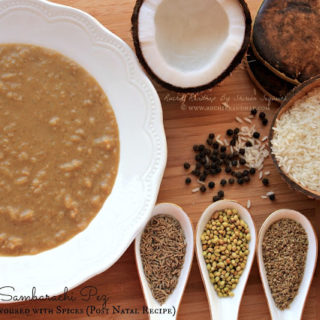
Sambarachi Pez – Rice Gruel (Kanji) Flavoured with Spices
Sambarachi Pez or spiced rice gruel is a traditional post natal dish prepared during the post delivery confinement period and is believed to greatly benefit the new mom and aid lactation.
Print
Pin
Rate
Ingredients
- 1-1/2 cups raw rice surai/belthige/kolam or even broken basmati
- 1-1/2 to 2 cups water
- salt to taste
- 1 cup thick coconut milk 1st extract * see notes
- 3 cups thin milk (2nd and 3rd extracts)
- 1-1/2 discs (approx 100 grams or to taste) palm jaggery (pele god/vole bella)
- 1/8 cup ghee
For the spice roce (extract):
- 6 tablespoons coriander seeds
- 1 teaspoon cumin seeds
- 1 teaspoon carom seeds ajwain/omam
- 1 teaspoon peppercorns
- 1 teaspoon mustard seeds
Instructions
- Grind all the ingredients mentioned under ‘For the masala’ to a paste using 3-4 tablespoons of water (from the 1/2 cup) and transfer the contents into a muslin cloth and squeeze out the juice into a bowl. Repeat the process adding the balance amount of water to the ground paste and squeeze out the juice. The process should yield 1/2 cup of this juice. Discard the ground ingredients (‘kojanti’ as we say in Mangalore)
- Pressure cook the raw rice, water and salt till the rice is soft and tender (about 3-4 whistles). Let the pressure cooker cool down to room temperature then open and stir the contents.
- Add the masala extract (ground and extracted), thin coconut milk and powdered jaggery to the cooked rice and cook on a medium low heat till the jaggery melts. Stir every now and then to avoid the mixture from scorching.
- Add the thick coconut milk and give it one boil on a low heat – keep an eye on this as thick coconut milk can curdle very easily.
- Add the ghee, mix and remove from heat. Serve hot.
Notes
1. If you are serving this to a new mother during her confinement period always use freshly extracted coconut milk. Do not use commercially available coconut milk powder (dehydrated) or coconut milk from tins mainly because they contain preservatives which is avoidable at all costs. To extract 1 cup of thick milk and 3 cups of thin milk you need approx 2 cups of freshly grated coconut (from 1 large coconut)
2. This dish was prepared for me by my ‘balnti-posteli’ during my post delivery confinement. I did not prepared it personally as I was still on bed rest, but I requested the lady to measure all the ingredients using my standard measuring cups and give me the accurate recipe which I typed out as she dictated it. Please use your judgement while preparing this.
3. Since this yields quite a bit of gruel it was refrigerated and served to me the next day too. I think I ate this for 2 days (don’t quite remember). If you subscribe to the old school of thought and believe that new moms must be served fresh food everyday then please halve the recipe or scale it down to meet your requirements.
4. Do note that the amount of coriander seemed too much to me too and its flavour stood out very strongly in the kanji but I was made to eat it anyway. If you are experienced in preparing confinement foods then please adjust the quantities of the masala accordingly.
5. This is a traditional collection of home remedies and each of these has been either cooked or tried personally by me. If you have a medical condition/health problem please consult your doctor before trying out any of the pre or postnatal recipes.
2. This dish was prepared for me by my ‘balnti-posteli’ during my post delivery confinement. I did not prepared it personally as I was still on bed rest, but I requested the lady to measure all the ingredients using my standard measuring cups and give me the accurate recipe which I typed out as she dictated it. Please use your judgement while preparing this.
3. Since this yields quite a bit of gruel it was refrigerated and served to me the next day too. I think I ate this for 2 days (don’t quite remember). If you subscribe to the old school of thought and believe that new moms must be served fresh food everyday then please halve the recipe or scale it down to meet your requirements.
4. Do note that the amount of coriander seemed too much to me too and its flavour stood out very strongly in the kanji but I was made to eat it anyway. If you are experienced in preparing confinement foods then please adjust the quantities of the masala accordingly.
5. This is a traditional collection of home remedies and each of these has been either cooked or tried personally by me. If you have a medical condition/health problem please consult your doctor before trying out any of the pre or postnatal recipes.
Disclaimer
The nutritional values are only indicative.
Tried this recipe?Please leave a comment & rate the recipe below or share a photo on Instagram and tag me @ruchikrandhap
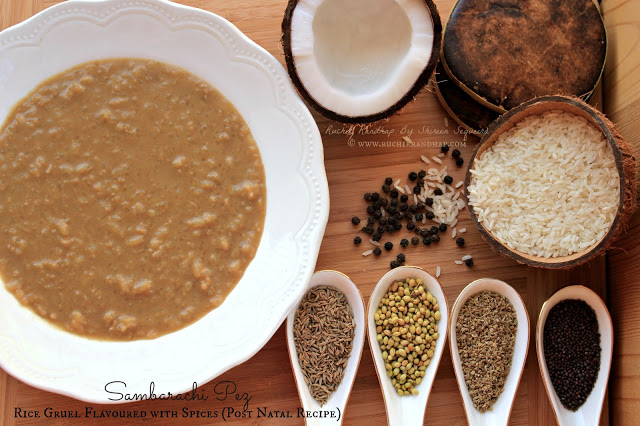
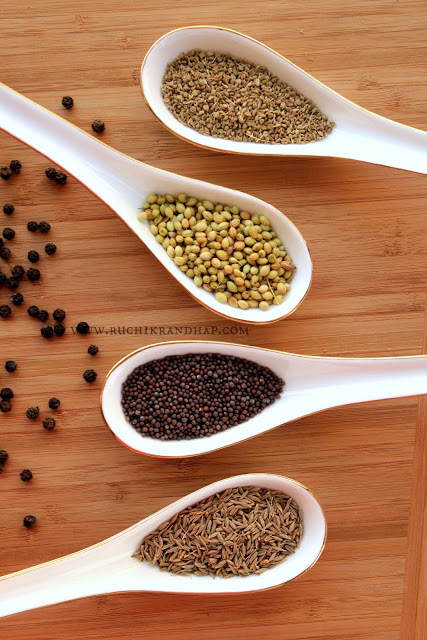
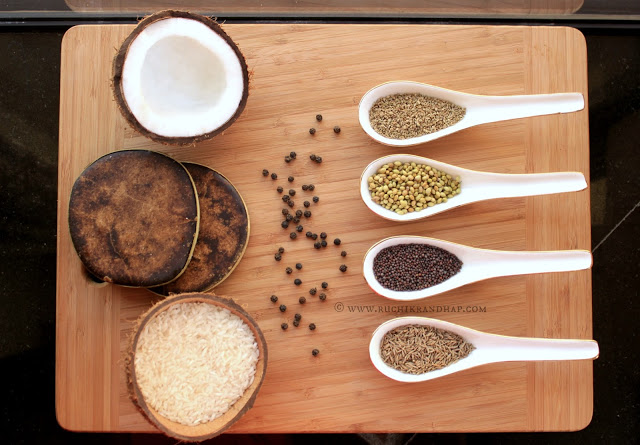
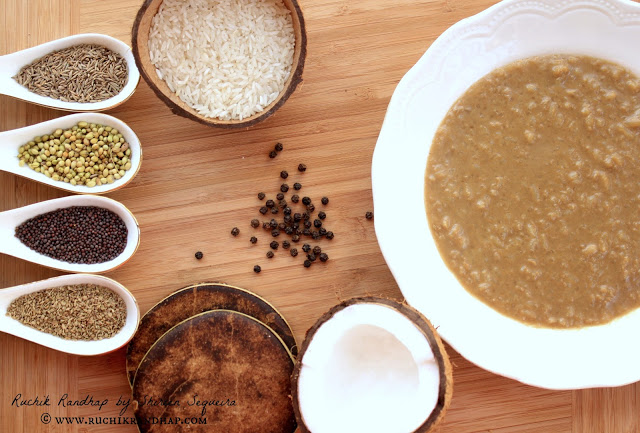
Can you please give me the name of your Baltein Posteli lady in Dubai so i can contact her as i need her services for massage and cooking these recipes.
Sorry but I don’t have her latest number. She worked for me over 10 years ago